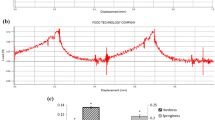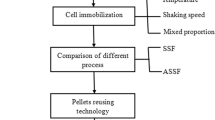Abstract
Beer was brewed continuously with Saccharomyces uvarum immobilized in calcium alginate gel beads. When wort fermented for a short period, and containing 8.5 mg/l of dissolved oxygen, was pumped into the bottom of a 2.5 l column reactor packed with immobilized yeast beads (54 percent of the total column volume) at a flow rate of 120 ml/h, 2.25 mg/l of total diacetyl was formed. However, when the wort contained 0.04 mg/l of dissolved oxygen, only 0.05 mg/l of total diacetyl was formed. Based on these results, a new fermentation system incorporating an immobilized yeast reactor was developed for the rapid production of beer of excellent quality containing a low level of diacetyl precursors.
This is a preview of subscription content, access via your institution
Access options
Subscribe to this journal
Receive 12 print issues and online access
$209.00 per year
only $17.42 per issue
Buy this article
- Purchase on Springer Link
- Instant access to full article PDF
Prices may be subject to local taxes which are calculated during checkout
Similar content being viewed by others
References
White, F.H. and Portno, A.D. 1978. Continuous fermentation by immobilized brewers yeast. J. Inst. Brew. 84: 228–230.
Godtfredsen, S.E., Ottesen, M. and Svensson, B. 1981. Application of immobilized yeast and yeast coimmobilized with amyloglucosidase in the brewing process. Proc. Eur. Brew. Conv. Gong. 19: 505–511.
Pardonová, B., Poledniková, M., Šedová, H., Kahler, M. and Ludvik, J. 1982. Biocatalvst for beer production. Brauwissenschaft. 35: 254–258.
Gestrelius, S. 1982. Potential application of immobilized cells in the food industry: malolactic fermentation of wine. Enzyme Eng. 6: 245–250.
Totsuka, A. and Hara, A. 1981. Decomposition of malic acid in red wine by immobilized microbial cells. Hakkokogaku Kaishi. 59: 231–237.
Osuga, J., Suzue, H., Mori, A. and Wada, M. 1980. Brewing of vinegar by immobilized acetic acid bacteria. Abstracts, 1980 Annual Meeting of the Society of Fermentation Technology, Japan, p. 80.
Sato, Y., Sato, H., Sato, N. and Murai, K. 1983. Immobilization of microorganisms and enzymes and its application. Report of the Iwate Brewing and Food Manufacturing Research Institute. 17: 204–209.
Akao, G., Nagata, S., Osaki, K. and Okamoto, Y. 1982. Gontinuous production of shoyu-like solution by immobilized lactic acid bacteria and yeast. Abstracts, 1982 Annual Meeting of the Society of Fermentation Technology, Japan, p. 26.
Inoue, T. 1982. Further studies on an improved micromethod for determination of total diacetyl in beer. The Research Laboratories of Kirin Brewery Co., Ltd. p. 13–20.
Committee of the EBC. 1975. Free α-Amino nitrogen in wort and beers. Analytica-EBC 3rd. edition. E.61–E.63. Schweizer Brauerei-Rundschau, Zurich, Switzerland.
Inoue, T. and Yamamoto, Y. 1971. Decomposition rate of precursors of diacetyl and 2,3-pentanedione during beer fermentation. The Research Laboratories of Kirin Brewery Co., Ltd. p. 55–59.
Wainwright, T. 1974. Control of diacetyl. The Brewer. 60: 638–643.
De Clerk . 1965. “Lehrbuch der Brauerei Bd.2”, 2 Aufl., Versuchsund Lehranstalt für Brauerei in Berlin, p. 664.
Author information
Authors and Affiliations
Rights and permissions
About this article
Cite this article
Onaka, T., Nakanishi, K., Inoue, T. et al. Beer Brewing with Immobilized Yeast. Nat Biotechnol 3, 467–470 (1985). https://doi.org/10.1038/nbt0585-467
Received:
Accepted:
Issue Date:
DOI: https://doi.org/10.1038/nbt0585-467



